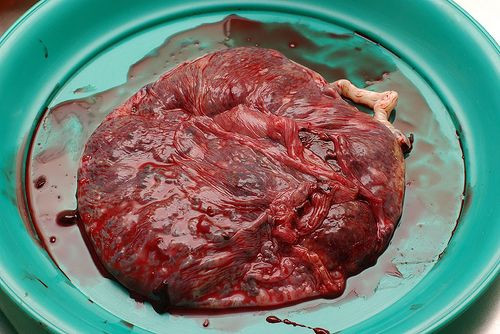Man Mixes Wife's Placenta Into Taco And Smoothie: 'It Tasted Exactly Like The Delivery Room Had Smelled'

Cooking up and eating a new mother’s placenta may seem like an unconventional and barbaric practice, but placentophagy has recently started to gain traction among parents-to-be in Europe and the United States. Advocates for placenta-eating claim the bloody piece of flesh can provide essential nutrients for a mother who has just given birth, considering it provided these nutrients for the baby during pregnancy. But why would a father even consider eating the organ that connected his child to his wife’s uterine wall?
“Since my wife and I first discussed having a child, the thought of this one-time opportunity to eat human placenta had been rolling around my mind,” health and travel writer, Nick Baines said on his blog via The Guardian. “Being inquisitively omnivorous, I wanted to know how it would taste; in the face of a fresh, still-warm placenta, I was less enthusiastic. The wobbly, knotted mass of fibrous, clot-like flesh was bigger than I expected and somewhat intimidating.”
After some heavy deliberation over acting on the thought, Baines left the hospital, as he puts it, “with my wife, our newborn son and a doggy bag.” Again, he wondered how he would go about eating his wife’s recently discharged placenta. In making his decision on the preferred method of cooking placenta, Baines took to Twitter for some feedback. Some of the suggestions included recipes for lasagna, pizza, and even one for a pâté. Ultimately, he decided on a raw smoothie with banana and coconut water, and a taco fried with garlic and paprika.
After watching the bloody, beef-like consistency blend together with banana and coconut water, it finally came time to taste his concoction. “Up front was the distinct flavor of banana, superseded by a metallic, bloody backnote. It had a mineral earthiness to it and tasted exactly like the delivery room had smelled.” Although his raw placenta smoothie was admittedly less palatable than he thought, he had higher hopes for the placenta taco. While seasoning it on his cutting board and getting ready to fry it up, he noticed it was more appetizing than he imagined. “The meat was rich, with a beef-like quality. It was tender, kind of like roast brisket and not dissimilar to Texas BBQ.”
Although a father’s decision to cook up his wife’s placenta is a relatively new occurrence among placentophagy researchers, mothers who do so to combat postpartum depression and for other perceivable healthy benefits have received quite a bit of attention. A recent study conducted by UNLV anthropologists asked women who had recently given to birth to comment on their placenta-eating experience. The research team surveyed 189 American women, who had recently consumed their own placenta after giving birth. The women included in the study were Caucasian, married, middle class, college-educated, and more likely to give birth at home.
Each mother was asked why they decided to eat their own placenta, their preparation method, and if they had intentions of doing it again. Seventy-six percent of the group reported positive feedback about consuming their own placenta. Many said it contributed to various health benefits including treatment of post-partum symptoms, increased lactation, and a better mood. Certain negative side effects included unpleasant burping, headaches, and an unappealing taste or smell. Even though some women reported consuming it in a raw or cooked form, the preferred method was dehydrating it into an easier to digest capsule form.
“Our survey participants generally reported some type of perceived benefit from the practice, felt that their postpartum experience with placentophagy was a positive one, and overwhelmingly indicated that they would engage in placentophagy again after subsequent pregnancies,” the authors said in a statement.



























